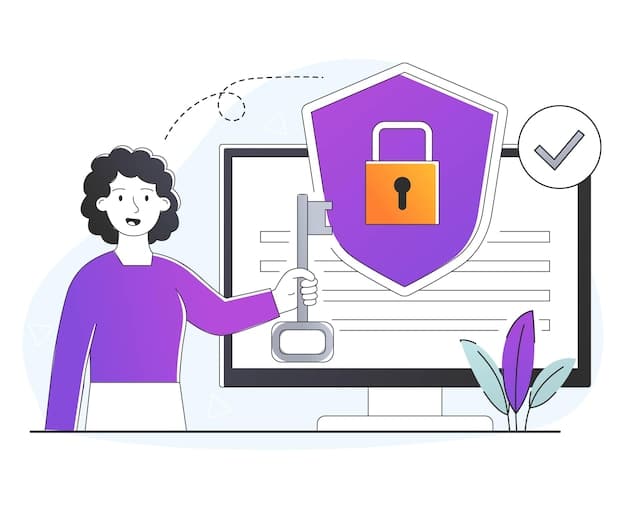How to Understand Privacy Policies: A US Consumer Guide

How to Read and Understand Privacy Policies: A Guide for US Consumers breaks down the complex language and legal jargon of online privacy policies, empowering you to protect your personal data and make informed decisions about your digital footprint.
Navigating the digital world requires a critical understanding of the agreements we enter into daily. This article, How to Read and Understand Privacy Policies: A Guide for US Consumers, arms you with the knowledge to decipher these often-complex documents and safeguard your personal information.
Why Reading Privacy Policies Matters for US Consumers
Privacy policies are fundamental to ensuring transparency and control over your digital footprint in the USA. They outline how companies collect, use, and share your personal information. Ignoring them can lead to unintended consequences, from data breaches to unwanted marketing.
Understanding these policies empowers you to make informed decisions about the websites you visit, the apps you download, and the services you use. It’s about taking control of your data and ensuring your privacy rights are respected.
The Risks of Ignoring Privacy Policies
When you don’t read privacy policies, you’re essentially giving companies a blank check to do whatever they want with your data. Here’s what could happen:
- Your personal information could be sold to third-party advertisers without your knowledge.
- You could be enrolled in unwanted marketing campaigns.
- Your data could be vulnerable to breaches and cyberattacks.
- You’re agreeing to terms that favor the company, not you.
Benefits of Understanding Privacy Policies
Conversely, when you read and understand privacy policies, you gain several advantages:
- You know exactly what data is being collected about you.
- You can control how your data is used.
- You can opt out of data collection practices you’re not comfortable with.
- You are less vulnerable to privacy violations.
In short, reading privacy policies is not just a good idea; it’s essential for protecting your digital well-being in the US.
Key Sections to Focus on in a Privacy Policy
Privacy policies can be lengthy and dense, but certain sections are more important than others. Focusing on these key areas will allow you to quickly understand the most critical aspects of the policy.
Knowing where to focus your attention can make the daunting task of reading a privacy policy much more manageable. Prioritize these sections to quickly understand the core aspects of how your data is handled.
Data Collection Practices
This section describes the types of personal information the company collects. Look for specifics, such as:
- Contact information (name, email address, phone number).
- Demographic data (age, gender, location).
- Browsing history and website activity.
- Device information (IP address, operating system).
Data Usage
This section outlines how the company uses your data. Be on the lookout for vague language like “to improve our services.” Understand what the company actually does with your information.
Data Sharing
This section details with whom the company shares your data. Pay close attention to whether data is shared with:
- Affiliates and subsidiaries.
- Third-party advertisers.
- Data brokers.
- Law enforcement agencies.

Decoding the Legal Jargon: Common Terms and Definitions
Privacy policies are often filled with legal jargon and technical terms that can be confusing. Understanding these terms is essential to truly grasping the policy’s implications.
Many privacy policies use convoluted language to obscure their true meaning. Familiarizing yourself with common legal and technical terms can empower you to see through the complexities.
“Personal Information”
This is a broad term that refers to any information that can be used to identify you as an individual. This includes:
- Your name and contact details.
- Your social security number.
- Your financial information.
- Your medical records.
“Data Controller” vs. “Data Processor”
The data controller is the entity that determines the purposes and means of processing personal data. The data processor processes data on behalf of the controller.
“Cookies” and “Tracking Technologies”
Cookies are small text files stored on your device that track your browsing activity. Tracking technologies encompass various methods used to collect data about your online behavior which include:
- Pixels tags.
- Web beacons.
- Device finger printing.
Understanding these terms allows you to better interpret the privacy policy and assess the potential risks to your personal data.
Tools and Resources for Analyzing Privacy Policies
Several tools and resources can help you analyze privacy policies more efficiently. These resources can save you time and provide valuable insights into the terms and conditions.
Automated tools can simplify the process of understanding complex privacy policies. Utilizing these resources allows you to quickly identify key terms and potential privacy risks.
Privacy Policy Analysis Tools
These tools use artificial intelligence to analyze privacy policies and highlight key terms, data collection practices, and data sharing agreements. Some examples include:
- Terms of Service Didn’t Read (ToS;DR).
- Polisis.
- Privacy Analyzer.
Browser Extensions
Browser extensions can alert you to websites with questionable privacy practices. They can also block trackers and cookies that collect data about your browsing activity. Some examples include:
- Privacy Badger.
- DuckDuckGo Privacy Essentials.
- Ghostery.
Consumer Advocacy Groups
Organizations like the Electronic Frontier Foundation (EFF) and the Center for Digital Democracy (CDD) provide valuable resources on digital privacy issues. They also advocate for pro-consumer privacy laws. You can find more information on the following resources:
- Electronic Frontier Foundation – EFF: https://www.eff.org/
- Center for Digital Democracy – CDD: https://www.democraticmedia.org/

Understanding Your Rights Under US Privacy Laws
US privacy laws give consumers certain rights regarding their personal information. Knowing these rights empowers you to protect your data and hold companies accountable.
While the US lacks a comprehensive federal privacy law, several state laws and regulations provide important protections. Understanding these rights allows you to assert control over your personal data.
California Consumer Privacy Act (CCPA)
The CCPA grants California residents the following rights:
- The right to know what personal information is being collected about them.
- The right to delete their personal information.
- The right to opt out of the sale of their personal information.
- The right to non-discrimination for exercising their CCPA rights.
Children’s Online Privacy Protection Act (COPPA)
COPPA protects the privacy of children under 13 years old. It requires websites and online services to obtain parental consent before collecting, using, or disclosing personal information from children.
Other State Privacy Laws
Several other states, including Virginia, Colorado, and Utah, have enacted comprehensive privacy laws. These laws grant consumers similar rights to those under the CCPA.
Taking Action: Protecting Your Privacy in the Digital Age
Reading and understanding privacy policies is just the first step. You must also take proactive steps to protect your privacy online. Here are some key strategies.
Being informed about privacy policies is essential, but translating that knowledge into action is even more critical. Adopt these practical strategies to safeguard your digital footprint.
Adjust Your Privacy Settings
Review the privacy settings on your social media accounts, email accounts, and other online services. Limit the amount of personal information you share and control who can see your posts and profile information. Consider the following settings:
- Limit profile visibility to friends only.
- Turn off location tracking.
- Disable personalized ads.
Use Strong Passwords and Enable Two-Factor Authentication
Use strong, unique passwords for all your online accounts. Enable two-factor authentication (2FA) whenever possible to add an extra layer of security.
Be Mindful of What You Share Online
Think before you post. Once something is on the internet, it’s difficult to remove completely. Be cautious about sharing sensitive information online, such as your address, phone number, or financial details. Consider these factors before posting:
- Avoid oversharing personal details.
- Be wary of phishing scams.
- Report any suspicious activity.
| Key Point | Brief Description |
|---|---|
| 🧐Data Collection | Understand what personal data is gathered by websites and apps. |
| 🤝Data Sharing | Know who your data is shared with, including third parties. |
| 🛡️Privacy Rights | Be aware of your rights under laws like CCPA and COPPA. |
| 🔑Privacy Settings | Control your privacy through settings on social media and online services. |
FAQ
▼
A privacy policy is a legal document that describes how a company collects, uses, manages, and discloses personal information. It’s important to read it carefully.
▼
Privacy policies are often lengthy and complex because they must cover a wide range of possible data collection and usage practices, as well as comply with various laws.
▼
Depending on where you live and the company’s location, you may have rights such as the right to access, correct, delete and restrict the use of your personal data.
▼
If you don’t agree with a company’s privacy policy, you should not use their services or products. Contact the company to express your concerns and ask for clarification.
▼
You should review privacy policies regularly, especially when there are updates or changes in the services you use. Aim to check them at least once a year.
Conclusion
Empowering yourself through understanding digital privacy policies in the US is essential for protecting your personal data and making informed decisions in the digital age. By recognizing your rights and taking action, you can secure your online presence against privacy breaches.





